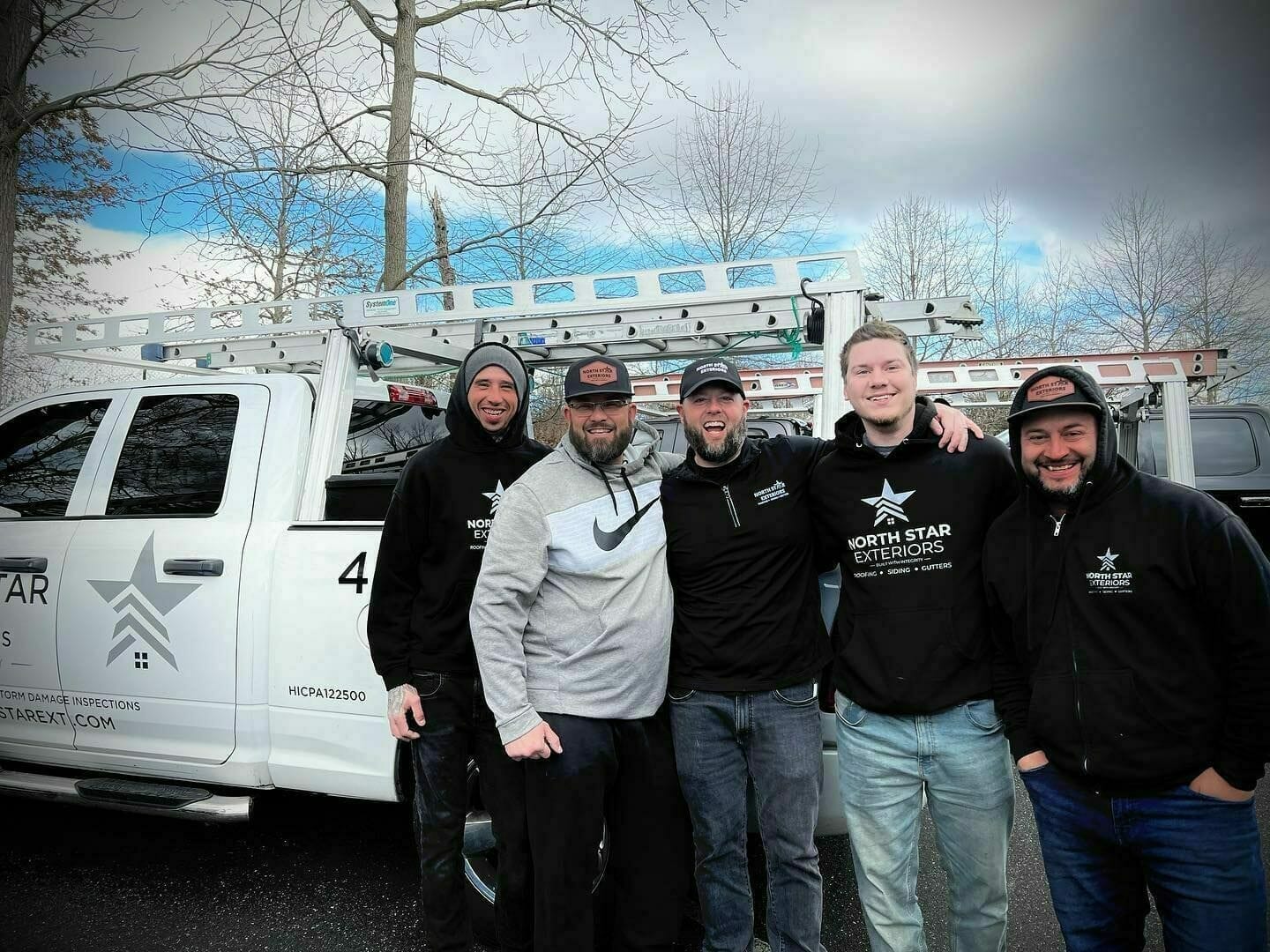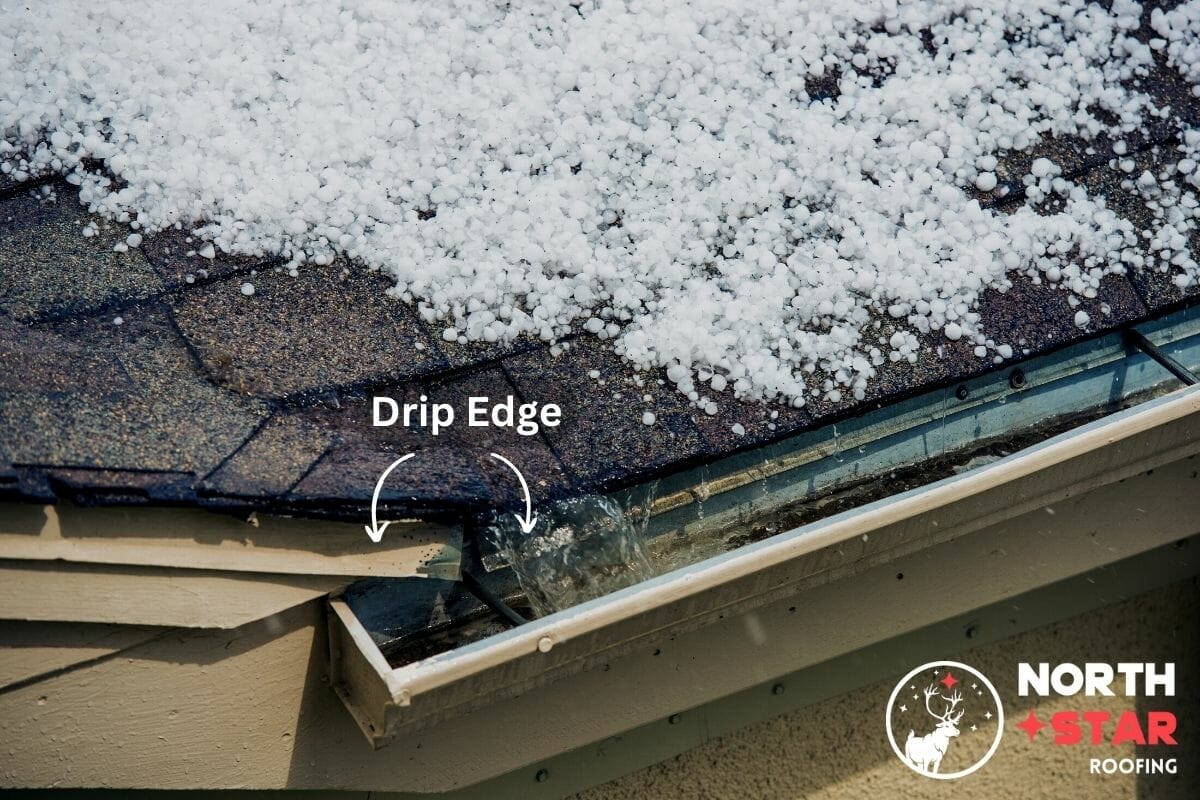You may have noticed something on your roof right below the edge of the shingles. That’s the drip edge, a crucial part of your roof that you should know about. If it is broken, or worse, you can’t see it, you must get a new one before the wind, water, or pests sabotage your home’s foundation.
At North Star Roofing, we’ve been helping homeowners make more informed decisions about their homes. Today, we are here to explain everything about drip edges in a simple way so that you can pick the right one for your home.
This article explains the following:
- What is a drip edge?
- Is it necessary for your home?
- How does a roof drip edge protect your home?
- Which type of drip edge is ideal for your home?
- Facts about drip edge installation
Let’s begin with the basics to understand all the details correctly.
What Is A Drip Edge?
A drip edge is a type of metal flashing installed along the edges of your roof. The purpose of installing it is to protect the home from damage caused by rainwater, pests, and high winds. It’s a small, visible, component that can easily get overlooked if you’re not a roofing professional, but a small detail like drip edge flashing can create a huge difference in the integrity of your roofing system.
Is A Drip Edge Necessary For Your Home?
The answer is yes, most of the time. Most building codes require some form of drip edge flashing to prevent wind and water from damaging your home. Weather damage is the primary reason homeowners will file insurance claims. Wind and water damage leads to rot, insects, rodents, mold, and algae affecting the following areas of your home:
- Roof
- Foundation
- Walls
- Ceiling
- Attic
- Siding
- Basement
- Porch
- Soffit and fascia
If you have a properly installed and functional drip edge, it can protect most of these areas efficiently.
Here is an explanation of how a drip edge can benefit you and your home.
Roof Drip Edges: Functions And Benefits
A standard drip edge prevents water from seeping behind the shingles and fascia, but this isn’t the only way they protect your home. Different types of drip edges perform multiple functions. Let’s learn about the incredible benefits of a good quality metal drip edge. You’ll be surprised to know how this tiny part of your roof plays a huge role in extending the life of your roofing components.
Prevent Water From Slipping Behind The Starter Shingles
A drip edge is installed right along the roof’s border, between the roof deck and the underlayment. This location enables the drip edge to stop water from slipping behind the starter shingles and damaging anything behind it, such as the roof deck and interior below. Roofers mostly install a starter row of shingles, that the shingle manufacturer provides, along the roof’s edge. The drip edge offers a layer of protection for the starter shingles to lay intact for years.
Seal The Roofers’ Gap
The roofers’ gap is an area between the rafters and the fascia board. It is usually a 1.5 to 2-inch space left when horizontal and vertical parts of the roof do not cover the sharp turns at the edges. In some cases, you can utilize this gap to ventilate the roof, but most times, it becomes an entryway for pests, rodents, and rainwater. Many drip edges are installed in a way that this gap is sealed, keeping away such unwanted elements.
Prevent Ice Dams
When the snow begins to melt on a roof, the water travels down from the warm peak in small amounts. On the way, and once it reaches the roof’s edge, it freezes again, turning into big chunks of ice called ice dams. The weight of an ice dam pushes the roof and gutters down until they start sagging. Ice dams also stop water from running off your roof, forcing it to leak into the shingles below, so you must get rid of them quickly.
A roof drip edge is designed to prevent this problem. If you use metals like aluminum, it can trap heat, helping the snow to melt. Alternatively, you can install heat cables along a drip edge that is longer than the standard profile. Heat cables are thin electrical wires that radiate heat, effectively melting a lot of snow and ice around them. Some homeowners attach these wires to the shingles, but it’s not ideal to do so. The clips and sealants used to install heat cables can cause the shingle granules to fall off.
Prevent Wind Damage
Gusts of wind can cause the shingles to become brittle over time. Strong winds and storms can also blow through the roofline, lifting the shingles and potentially causing them to tear off. Again, a roof drip edge comes to the rescue. It minimizes wind damage by keeping the starter shingles intact and attached tightly to the roof.
There are multiple metals and styles available on the market. Roofers usually cut and install the metal flashing strips on site after inspecting your roof and measuring the edges for a custom fit.
Roof Drip Edge Types
Metals like steel, aluminum, and copper are the most common materials used to make drip edge flashing. Let’s learn more about each material in detail, so you can pick one easily.
Drip Edge Metals
There are a lot of different types of metal used to develop a roof drip edge, and each one of them can be painted to match your home’s aesthetics. The most common metals used are steel, aluminum, copper, and zinc. Steel is the most affordable option, while copper is the most durable choice.
Steel Drip Edge
Steel has an affordable price and is easy to work with. However, steel is prone to rust after water exposure, so roofing contractors always offer to coat a steel drip edge with a rustproof layer of paint, or aluminum, before installation. If you want a white, black, or specific colored roof drip edge, make sure to inform your roofer early on.
Aluminum Drip Edge
Aluminum is already noncorrosive, so it is a much better material option for homes. That’s why professional roofing contractors recommend using aluminum for roof flashing work. Aluminum is lightweight and more durable than steel and reflects a clean, silvery finish. It’s also more resistant to heat and UV damage.
Copper Drip Edge
Copper is an excellent choice if you want to go with drip edge material that will last for a lifetime without deteriorating. It costs more than steel and aluminum since it’s a luxurious metal, but the good part is that drip edges are only a small part of the roof. So using copper may be an intelligent one-time investment. The lustrous brown metal fulfills the role of offering maximum protection for your home, while also improving its curb appeal.
Selecting and installing a drip edge material is a careful process. There are multiple factors that determine which type of drip edge is suitable for your home.
Some of these factors include:
- Local weather conditions,
- The roof’s angle,
- Length of the eaves; and
- Size of the fascia board.
The next step is selecting the best profile, or shape, for the drip edge. The shape ensures which parts of your home receive protection, and to what extent this protection takes place.
Drip Edge Styles/Profiles
The drip edge flashing comes in three common shapes. All drip edge styles are installed under the shingles along the eaves, so each one protects the fascia board and attic from wind damage, water, and pests. However, they each differ in their ability to direct water away from home.
C Style Drip Edge
A type C drip edge is the oldest style. It offers basic protection, which may or may not be suitable for your home. Installing a C-style drip edge is the minimum requirement put forth by building codes in most areas of the United States. It is easy to install and costs less, but it cannot protect the fascia board adequately from water damage with such a short bottom flange.
D Style Drip Edge
Type D drip edge flashing is currently the most popular style. It is highly effective at directing the water away from the fascia boards, which is why most roofing contractors, manufacturers, and builders’ associations recommend the D-style drip flashing.
F Style Drip Edge
This is a more advanced drip edge flashing, which is the best choice for optimal protection. A type F style directs the maximum amount of water into the gutters, which is why this type of drip edge is known as a gutter apron. It extends further away from the edge of your roof, protecting the porch and foundation along with the fascia board and shingles. However, the F-style drip flashing is more beneficial if installed during a roof replacement project.
Now, you may wonder whether installing the drip edge over existing shingles is a bad idea, or not. So here’s some clarification for your doubts.
Can You Install A Drip Edge On An Existing Roof?
The ideal time to install a drip edge is during a roof replacement or new shingle installation because the it must be installed under the shingles. To install them over an existing roof, you’ll have to remove and renail the old shingles, which may decrease the lifespan of the shingles if not done carefully.
To prevent roofing faults, it’s best to skip DIYs and handymen. Installing a small piece of metal may seem easy, but as the saying goes, ‘the devil is in the details’. Incorrect nailing, cracking shingles, and damaged wood are common mistakes that come with having less experience and no license.
The solution is to hire a reliable roofing contractor who is licensed and highly experienced. Research local roofers first, as they’re familiar with your area, and know the roofing components that will suit your local weather conditions. A licensed roofing company is also insured and bonded, which means it can cover any damage caused during installation, but in reality, the chances of such faults and damage occurring are equal to none when you hire a specialist. A good professional roofer is trained to conduct and manage the project from start to finish carefully.
If you are looking for dip edge installation in Lansdale, PA, we can help you.
Discuss Roof Drip Edge Installation With The Experts
For years, North Star Roofing has been improving homes in Lansdale, North Wales, and the surrounding areas in Pennsylvania. We are one of the most trusted roofing contractors with a team that thrives on honest, and meticulous work. We suggest installing a proper drip edge, as it’s an easy way to add more value and protect your home. This small piece of metal is affordable, even to have it installed. If you want to discuss your roof replacement project or learn more about different residential roof components, call us at (484) 302-7663. We will be happy to offer you a free consultation and estimate.


